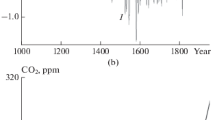Abstract
Radiocarbon 14C is a cosmogenic isotope, which is most extensively used by scientists from a wide variety of fields. Its rate of generation in the atmosphere depends on solar modulation and thus, studying 14C concentration in natural archives, one can reconstruct solar activity level in the past. The paper shows results of box-model calculations of generation of the 14C isotope in the atmosphere and its relative abundance during the time interval 1389–1800 AD, taking into account influence of changing climate. This interval includes the deep minimum of solar activity and period of significant change in atmospheric concentration of CO2 and global temperature. The performed analysis showed that concentration of 14C in the atmosphere reflects not only variations of the galactic cosmic rays intensity but as well changes of temperature and atmospheric CO2 concentration. It is shown that the decrease in CO2 concentration in the atmosphere during 1550–1600 can be connected with absorption of CO2 by the ocean surface layer. Thus, taking into account the climatic changes is an important condition for the reconstruction of solar activity in the past using data based on cosmogenic isotopes.
Similar content being viewed by others
References
Bard E, Raisbeck G, Yiou F and Jouzel J, 2000. Solar irradiance during the last 1200 years based on cosmogenic nuclides. Tellus B 52(3): 985–992, DOI 10.1034/j.1600-0889.2000.d01-7.x.
Beer J, Blinov A, Bonani G, Hofmann HJ, Finkel RC, Lehmann B, Oeschger H, Sigg A, Schwander J, Staffelbach T, B. Stauffer B and Suter, 1990. Use of Be-10 in polar ice to trace the 11-year cycle of solar activity. Nature 347: 164–166, DOI 10.1038/347164a0.
Beer J, Joos F, Lukasczyk Ch, Mende W, Rodriguez J, Siegenthaler U and Stellmacher R, 1994. The Solar Engine and its Influence on Terrestrial Atmosphere and Climate. NATO ASI Ser., M. 25: 221–233.
Beer J, Mc Cracken K and von Steiger R, 2012. Cosmogenic Radionuclides: Theory and Applications in the Terrestrial and Space Environments. London. Springer: 426pp.
Berggren AM, Beer J, Possnert G, Aldahan A, Kubik P, Christl M, Johnsen SJ, Abreu J and Vinther BM, 2009. A 600-year annual 10Be record from the NGRIP ice core, Greenland. Geophysical Research Letters 36: L11801, DOI 10.1029/2009GL038004.
Butzin M, Prange M and Lohmann G, 2012. Readjustment of glacial radiocarbon chronologies by self-consistent three-dimensional ocean circulation modeling. Earth and Planetary Science Letters 317–318: 177–184, DOI 10.1016/j.epsl.2011.11.046.
Dergachev VA and Ostriakov VM, 1978. O vliyanii variatsui temperaturu na uroven radiougleroda v zemnoi atmosphere (On the influence of temperature variations on the radiocarbon level in the Earth’s atmosphere). In Proc. 6th All-Union Conference “Astrophysical Phenomena and Radiocarbon”, 13–15 October 1976, Tbilisi. University of Tbilisi: 177–182. (in Russian)
Dergachev VA and Veksler VS, 1991. Primenenie radiouglerodnogo metoda dly izucheniy prirodnoi sredu proshlogo (Application of radiocarbon method for researching the natural environment in the past). Leningrad. PhTI: 258 pp. (in Russian).
Dorman LI, 1978. Osobennosti issledovaniy variatsui kosmicheskih luchei radiouglerodnum metodom (Peculiarities of cosmic ray variations studies by means of radiocarbon technique). In Proc. 6th All-Union Conference “Astrophysical Phenomena and Radiocarbon”, 13–15 October 1976, Tbilisi. University of Tbilisi: 49–96. (in Russian).
Esper J, Cook ER and Schweingruber FH, 2002. Low-Frequency Signals in Long Tree-Ring Chronologies for Reconstructing Past Temperature Variability. Science 295: 2250–2253. DOI 10.1126/science.1066208.
Etheridge DM, Steele LP, Langenfelds RL, Francey RJ, Barnola J-MI and Morgan VI, 1998. Historical CO2 record derived from a spline fit (75 year cutoff) of the Law Dome DSS, DE08, and DE08-2 ice cores. Division of Atmospheric Research, CSIRO, Aspendale, Victoria, Australia. Laboratoire of Glaciologie et Geophysique de l’Environnement, Saint Martin d’Heres-Cedex, France. Antarctic CRC and Australian Antarctic Division, Hobart, Tasmania, Australia.〈http://cdiac.ornl.gov/ftp/trends/co2/lawdome.smoothed.yr75〉.
Lal D, 1987. 10Be in polar ice: data reflect changes in cosmic ray flux or polar meteorology. Geophysical Research Letters 14(8): 785–788, DOI 10.1029/GL014i008p00785.
Libby WF, 1955. Radiocarbon Dating. Chicago-London-Cambridge. 175 pp.
Lowe DC and Allan W, 2002. A simple procedure for evaluating global cosmogenic 14C production in the atmosphere using neutron monitor data. Radiocarbon 44(1): 149–157.
Meissner KJ, 2007. Younger Dryas: A data to model comparison to constrain the strength of the overturning circulation. Geophysical Research Letters 34, L21705, DOI 10.1029/2007GL031304.
Nagovitsyn YA, 2007. Ob “obratnoi zadache” balansa radiougleroda (On inverse problem of radiocarbon balance). Proc. XI Pulkovo Int. Conf. on Solar Physics, St. Petersburg: Pulkovo, 2007: 271. (in Russian).
Ogurtsov MG, 2004. New Evidence for Long-Term Persistence in the Sun’s Activity. Solar Physics 220(1): 93–105, DOI 10.1023/B:sola.0000023439.59453.e5.
Peristykh AN and Damon PE, 1998. Modulation of atmospheric 14C concentration by the solar wind and irradiance components of the Hale and Schwabe solar cycles. Solar Physics 177(1–2): 343–355, DOI 10.1023/A:1004982321191.
Siegenthaler U and Sarmiento JL, 1993. Atmospheric carbon dioxide and the ocean. Nature 365: 119–125, DOI 10.1038/365119a0.
Singarayer JS, Richards DA, Ridgwell A, Valdes PJ, Austin WEN and Beck JW, 2008. An oceanic origin for the increase of atmospheric radiocarbon during the Younger Dryas. Geophysical Research Letters 35(14): L14707, DOI 10.1029/2008GL034074.
Shevenell AE, Ingalls AE, Domack EW and Kelly C, 2011. Holocene Southern Ocean surface temperature variability west of the Antarctic Peninsula. Nature 470: 250–254, DOI 10.1038/nature09751.
Stuiver M and Braziunas T, 1993. Sun, ocean, climate and atmospheric 14CO2, an evaluation of causal and spectral relationships. The Holocene 3(4): 289–305, DOI 10.1177/095968369300300401.
Zhilina TN, 2010. Maly lednikovy period kak odno iz kolebaniy klimata v golocene i ego posledstviya v zapadnoy Sibiri (Little Ice Age as one of the climatic oscillations during the Holocene and its consequences in West Siberia). Bulletine of the Tomsk State University 340: 206–210. (in Russian).
Takahashi T, Olafson J, Goddard JG, Chipman DW and Sutherland SC, 1993. Seasonal variation of CO2 and nutrients in the high-latitude surface oceans: A comparative study. Global Biogeochemical Cycles 7(4): 843–878, DOI 10.1029/93GB02263.
Author information
Authors and Affiliations
Corresponding author
About this article
Cite this article
Koudriavtsev, I., Dergachev, V., Nagovitsyn, Y. et al. On the influence of climatic factors on the ratio between the cosmogenic isotope 14C and total carbon in the atmosphere in the past. Geochron 41, 216–222 (2014). https://doi.org/10.2478/s13386-013-0161-2
Received:
Accepted:
Published:
Issue Date:
DOI: https://doi.org/10.2478/s13386-013-0161-2



